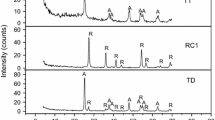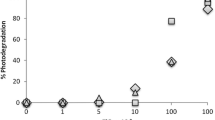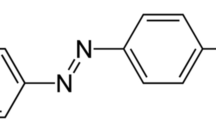Abstract
The scope of this work was to explore the application of different TiO2 powders (P25, PC105, PC500 and their calcined forms) for the photocatalytic and sonocatalytic treatment of model wastewaters containing single pollutants and their mixtures; dyes: C.I. Reactive Violet 2 (RV2), C.I. Mordant Yellow 10 (MY10) and oxalic acid. The influence of the applied catalyst type on the photocatalytic and sonocatalytic efficiency was explored with the emphasis on crystalline form and granulometric properties of powders. Generally, TiO2 powders, which were applied as obtained, demonstrated higher photocatalytic activity (~20 % of organic content oxidized in the mixture of dyes and oxalic acid in 30 min) while their calcined forms were shown to be more prominent as sonocatalysts (up to 13 % of organic contents oxidized in 30 min). The XRD analysis of calcined TiO2 powders confirmed the predominant crystal form of rutile. The degradation and mineralization kinetics of dyes RV2, MY10, oxalic acid and their mixtures was studied. In general, experimental results fitted well (R2 > 0.94) to the half and first order reaction rate model, pointing at the two ongoing mechanisms, i.e. reaction with ·OH radicals and direct electron transfer between adsorbed molecules and catalyst surface. A certain deviation is observed for the model solution containing dye MY10. MY10 serve as a filter for the UV-A irradiation (λmax = 365 nm). A detailed kinetic study confirmed the two simultaneous kinetic pathways and the comparable mechanisms for oxalic acid and dyes photocatalysis. The performed study confirmed the similarity of occurring mechanisms in photocatalysis and sonocatalysis due to sonoluminescence, with the extent of acoustic cavitation in ·OH radical generation.








Similar content being viewed by others
Abbreviations
- \( d \) :
-
Particle size (expressed with diameter value) (m)
- \( d_{i} \) :
-
Particle size in size class i (m)
- \( \overline{{d_{i} }} \) :
-
Average particle size in size class i (m)
- d 3,2 :
-
Sauter mean diameter (m)
- \( d_{\text{p}} \) :
-
Pore size (expressed with diameter value) (m)
- \( d_{{{\text{p, av}} .}} \) :
-
Average pore size (expressed with diameter value) (m)
- \( {\text{d}}Q_{3} \left( {d_{i} } \right) \) :
-
Experimental data for volume content of entities in size interval \( i \) (−)
- \( q_{3} \left( d \right) \) :
-
Normalized volume probability density function (m−1)
- \( V \) :
-
Volume of adsorbed nitrogen gas that is pore volume (m3)
- V P :
-
Single point total pore volume (m3 g−1)
- \( S_{V} \) :
-
Estimated external surface area (m2 m−3)
- \( S_{\text{BET}} \) :
-
BET surface area (m2 g−1)
- \( \psi_{\text{Wa}} \) :
-
Wadel shape factor (−)
- \( i \) :
-
Discussed size interval (\( i = 1 \cdots 86 \))
- r:
-
Reaction rate, mol dm−3 s−1
- k:
-
Reaction rate constant, mol1−n dm3n−3 s−1
- n:
-
Reaction order
- X:
-
Extent, %
- [.]:
-
Molar concentration, mol dm−3
- ea :
-
Volumetric rate of photon absorption
- θ :
-
Surface coverage
- a :
-
Coefficient for calculation of surface coverage at t = 0
- b :
-
Coefficient for calculation of changes in surface coverage
- a k :
-
Exponential decay coefficient for reaction rate constants (s−1)
- λ:
-
Wavelength, nm
- λmax :
-
Wavelength of maxima absorption
- f :
-
Ultrasonic frequency, kHz
- UV-A:
-
Ultraviolet irradiation with maximum at 365 nm
- UV-C:
-
Ultraviolet irradiation with maximum at 254 nm
References
Arslan Alaton I, Balcioglu IA, Bahnemann DW (2002) Water Res 36:1143–1154
Pekakis PA, Xekoukoulotakis NP, Mantzavinos D (2006) Water Res 40:1276–1286
Konstantinou IK, Albanis TA (2004) Appl Catal B Environ 49:1–14
Grčić I, Papić S, Koprivanac N, Kovačić I (2012) Water Res 46:5683–5695
Grčić I (2011) Modelling of the photocatalytic and sonochemical process for the wastewater treatment. Ph.D. dissertation, University of Zagreb
Grčić I, Vujević D, Koprivanac N (2010) Chem Eng J 157:35–44
Beltran FJ (2003) In: Tarr MA (ed) Chemical degradation methods for wastes and pollutants—environmental and industrial applications. Marcel Dekker Inc., New York, pp 1–77
Herrmann J-M (1999) Catal Today 53:115–129
Mills A, Lee S-K (2004) In: Parsons S (ed) Advanced oxidation processes for water and wastewater treatment. IWA Publishing, Cornwall, pp 137–167
Han F, Kambala VSR, Srinivasan M, Rajarathnam D, Naidu R (2009) Appl Catal A Gen 359:25–40
Wang J, Jiang Z, Zhang L, Kang P, Xie Y, Lv Y, Xu R, Zhang X (2009) Ultrason Sonochem 16:225–231
Eren Z, Ince NH (2010) J Hazard Mater 177:1019–1024
Kim JK, Martinez F, Metcalfe IS (2007) Catal Today 124:224–231
Shimizu N, Ogino C, Dadjour MF (2007) Ultrason Sonochem 14:184–190
Wang J, Jiang Z, Zhang Z, Zhao G, Zhang G, Ma T, Sun W (2007) Desalination 216:196–208
Pang YL, Abdullah AZ, Bhatia S (2011) Chem Eng J 166:873–880
Pang YL, Abdullah AZ (2012) Ultrason Sonochem 19:642–651
Wang J, Guo B, Zhang X, Zhang Z, Han J, Wu J (2005) Ultrason Sonochem 12:331–337
Ogi H, Hirao M, Shimoyama M (2002) Ultrasonics 40:649–650
Bahnemann D, Hilgendorff M, Memming R (1997) J Phys Chem 101:4265–4275
Krýsa J, Waldner G, Měštánková H, Jirkovsky J, Grabner G (2006) Appl Catal B Environ 64:290–301
Pozzo RL, Brandi RJ, Cassano AE, Baltanás MA (2010) Chem Eng Sci 65:1345–1353
Wang J, Ma T, Zhang Z, Zhang X, Jiang Y, Zhang G, Zhao G, Zhao H, Zhang P (2007) Ultrason Sonochem 14:246–252
Grčić I, Koprivanac N, Vujević D, Papić S (2008) J Adv Oxid Technol 11:91–96
Grčić I, Vujević D, Koprivanac N (2010) Chem Biochem Eng Q 24:387–400
Grčić I, Obradović M, Vujević D, Koprivanac N (2010) Chem Eng J 164:196–207
Her N, Park J-S, Yoon Y (2011) Chem Eng J 166:184–190
McMurray TA, Byrne JA, Dunlop PSM, Winkelman JGM, Eggins BR, McAdams ET (2004) Appl Catal A Gen 262:105–110
Kosanić MM (1998) J Photochem Photobiol A Chem 119:119–122
Guettai N, Ait Amar H (2005) Desalination 185:439–448
Kumar J, Bansal A (2012) Int J Environ Sci Technol 9:479–484
Didenko YT, McNamara WB III, Suslick KS (1999) J Phys Chem A 103:10783–10788
Acknowledgments
The authors would like to acknowledge the financial support from the COGITO bilateral project Air and water pollutants abatement on mesoporous silicates modified by oxide particles using advanced oxidation technologies (prof. Vesna Tomašić). The authors would also like to thank prof. Anne Davidson, UPMC, France for complementary analyses.
Author information
Authors and Affiliations
Corresponding author
Rights and permissions
About this article
Cite this article
Grčić, I., Vujević, D., Žižek, K. et al. Treatment of organic pollutants in water using TiO2 powders: photocatalysis versus sonocatalysis. Reac Kinet Mech Cat 109, 335–354 (2013). https://doi.org/10.1007/s11144-013-0562-5
Received:
Accepted:
Published:
Issue Date:
DOI: https://doi.org/10.1007/s11144-013-0562-5




